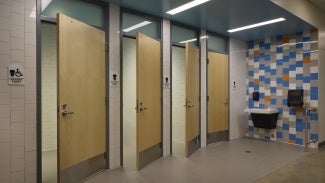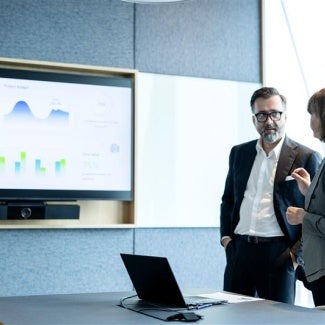Inclusive restrooms & locker rooms in K-12 schools
Contributed by Cheryl Jacobs, AIA, Greg Louviere, AIA, & Benjamin Fields, AIA
AIA Best Practices
Inclusive restroom & locker rooms offer a more human and dignified approach to the traditional experience with better student health outcomes.

Introduction
Changing access and supervision requirements are beginning to challenge the traditional norm of designing segregated, gender-specific restrooms and locker rooms for K-12 schools. Inclusive facilities, as described in this AIA Best Practices document, offer a more humane and dignified approach to the traditional toileting and locker room experience.
Inclusive restrooms and locker rooms are intended to provide an equitable experience for everyone, broader accessibility, more efficient use, enhanced supervision and organizational efficiency, and better student health outcomes.
Executive summary
This Best Practices guide will address how to discuss key issues surrounding the incorporation of inclusive restrooms and locker rooms in K-12 schools from design concept through construction. This document is unable to address every issue that may arise as each community is unique and will require unique solutions. Instead, we attempt to provide the reader with a general understanding of basic requirements and talking points to aid in the successful design and implementation of inclusive facilities in any project.
Inclusive restrooms and locker rooms do not have a single, agreed upon definition or term. When designed appropriately, they bring a variety of benefits to end users and administrators ranging from shorter wait times to greater accessibility and improved student mental and physical health. These facilities can reduce occurrences of bullying and other undesirable behaviors that have traditionally been associated with gender-specific “gang” restrooms in K-12 schools. Inclusive facilities can provide a greater sense of visual and acoustical privacy within individual rooms while enhancing sightlines in the shared circulation and handwashing area. Student safety is improved along with security and psychological well-being.
Definitions
What are inclusive restrooms and locker rooms, what should they be called, and who do they benefit?
Inclusive restrooms are highly visible, non-gender-segregated multi-user spaces with public circulation providing a mix of individual, private rooms that contain water closets or water closets and lavatories. Each room, or acoustically separated fully enclosed stall, allows individual users access to any open water closet, similar to the restrooms most people have at home.
Individual locker rooms are highly visible, non-gender-segregated multi-user spaces with public circulation providing a mix of individual, private rooms designed for students to change. Some rooms may also be equipped with showers based on district preferences. Lockers are arranged in a shared, semi-public space allowing access for students, teachers, and coaches without compromising privacy.
This guide will use the terms “inclusive restrooms” and “inclusive locker rooms,” however, there are many acceptable terms for these spaces that can be used depending on preference and audience. Since language can be a positive or negative trigger for many, it’s recommended each team use the term that best fits their community. For many, the term “single-user” best explains the purpose and intent of the design, helping smooth the transition from traditional facilities. Below is a short list of some suggested terms:
- All-access restrooms / locker rooms
- All gender restrooms / locker rooms
- Everyone restrooms / locker rooms
- Inclusive restrooms / locker rooms
- Individual restrooms / locker rooms
- Multi-user restrooms / locker rooms
- Single-user restrooms / locker rooms
- Universal restrooms / locker rooms
Regardless of how you refer to these spaces, they can provide huge benefits for each of the main user groups within the building:
- Students experience less bullying, increased ease of access, shorter wait times, and enhanced privacy.
- Faculty and staff have better supervision of shared grooming spaces and direct line of sight to water closet doors reducing opportunity for undesired behaviors.
- Parents, grandparents, or guardians can accompany children of any gender into the restroom and use the larger water closets with lavatories to help small children toilet, or to change infants.
- Visitors and community members benefit from shorter wait times and more access during events in the school.
1. Improving Student Physical & Mental Health
A. Bullying
School-based bullying, victimization, and violence most often occurs in hidden spaces away from supervision. Gender-specific multi-occupant student restrooms or locker rooms have long been spaces of bullying, graffiti, and other unsupervised student behavior. Inclusive facilities provide passive supervision of private toilet, changing, and shower rooms, thus reducing the likelihood of unwanted behaviors occurring in those spaces.
Design recommendations:
- Inclusive facilities shall be designed to increase supervision and provide nearby staff visibility to the shared grooming area. Except for maintaining privacy in each water closet or changing room, the entire facility shall be visible to any passerby, providing passive oversight that is absent from traditional facilities.
- Inclusive restroom and locker room design shall be welcoming and inviting. Feelings of safety are increased due to the increased visibility and openness in their design.
B. Anxiety & embarrassment
Many students avoid using the bathroom or changing their clothes for PE at school. The goal of inclusive facilities is to be welcoming while ensuring individual needs are met. About 7% of the population suffers from paruresis (“shy bladder syndrome”) or parcopresis (“shy bowel syndrome”). Many millions more have a milder case of embarrassment when going to the bathroom around their peers. Menstruating individuals prefer a quiet, personal space to unwrap and administer menstruation products. Students who cannot comfortably use the restroom at school, or choose not to due to anxiety, are disadvantaged.
Design recommendations:
- Inclusive facilities shall provide acoustically separated water closet rooms in restrooms and changing rooms in locker rooms. Acoustic separation may contribute to a reduction in anxiety over the pressure to “perform,” over adolescent body changes, or other mental health issues such as shy bladder syndrome.
- Travel paths around water closet rooms and changing rooms shall be wide enough as to not impede room access, cause waiting lines, or create any physical obstruction to limit access.
- Room arrangements can be numerous, but greater visibility and occupant comfort can be achieved by avoiding dead ends or blind spots where individuals can feel vulnerable. Layouts shall strive for a through flow of circulation which can contribute to better supervision.
- Where possible, individual water closet doors shall all be in one continuous row, or ‘L’ shape, as to not create a left and a right. People tend to pick a side or relegate a location to signify a group, a separation, or a gendered location. It is the intent of inclusive facilities to avoid sides or divisions in the facilities. When there is a left and a right side, even with the best intentions, one side may become the “boys” and the other the “girls” which reduces or negates many of the primary benefits of inclusive restrooms and locker rooms.
C. Time & access
Passing periods and short lunch times for middle and high school students don’t afford much time to use the restroom. Elementary school students access toilet facilities often as a class accompanied by a teacher or must request permission from a teacher during class time. At passing periods or recess time, students may wait to the last second to decide to go to the bathroom because they would rather play, socialize, or don’t want to miss out on a peer activity. Inclusive facilities offer students a more streamlined and efficient toileting experience encouraging them to use the facilities as the need arises. When ease of access increases, so does use and thus normalcy and universality.
Design recommendations:
- Ensure that inclusive facilities are well-lit and clearly marked with universal, standard signage to avoid visual confusion. Pictographs or symbols of toilets, showers, and sinks accompanied by simple language stating the primary purpose of the room (toilet, shower, changing room, etc.) are recommended. “Student restroom” and “Staff restroom” are clear indicators of purpose.
- Inclusive restrooms are more effective when distributed throughout the building, allowing students and staff to access them with ease during their day. It is recommended that they be located centrally off a commons or cafeteria, near main building entries, along major arteries of circulation, or within learning communities, and that they be visible from multiple spaces.
- Handwashing stations should have a prominent location and be easy to access from all major hallways. Their location allows students to use them quickly and easily on their way to and from classes whether they need to use the water closet or not. Additionally, locating handwashing in an open, easily accessed area encourages hand washing after using toilets.
- Consider the possibility of combining or co-locating PE lockers with academic lockers to reduce footprint and cost of equipment. Locating lockers together may increase student accessibility throughout the day and may provide a new paradigm for school layout.
D. Grooming
Personal grooming at a public mirror has historically been something done out in the open within gender-specific restroom spaces. This traditional arrangement may expose individuals to embarrassment, mockery, negative peer comparisons, and bullying.
Design recommendations:
- Locate mirrors along the path of travel to increase sightlines and avoid collisions of circulating individuals. It is likely that the public nature of the mirror will decrease use for personal grooming as well as the negative behaviors associated with traditional, gender-specific, facility mirror use.
- For personal grooming or other needs, a small mirror can be located on the back side of the individual water closet, changing, and shower room doors or on the side walls of the room.
E. Secure lock & in-use indicator
Locks on traditional restroom partition stalls are easily tampered with. Reports of failing stall door locks, or stall doors being opened from the outside by student peers are common occurrences. Situations like this can lead to increased student anxiety and an avoidance of restrooms altogether.
Design recommendations:
- Door hardware and locks in inclusive water closet rooms, changing rooms, and shower rooms shall have use indicators on both sides of the door. When an occupant knows that their door is locked from the inside and privacy is achieved, they feel at ease.
- Some options for indicators include red/green or ‘vacant’/‘occupied’ hardware; or a number of other solutions including a motion-activated light with transom glass above the door so that the room light sends an ‘in use’ signal when engaged.
- As an optional consideration, doors may utilize a 10-degree hold-open closer to provide a visual cue to differentiate occupied from unoccupied rooms at a distance.
- To ensure staff and administrative oversight in the event of a medical emergency, the door hardware should provide for a key override from the outside of the room. It is recommended that all doors swing out to avoid injury to a prone occupant and ensure that an occupant cannot resist the opening of the door.
2. Privacy
A. Actual & perceived privacy
Traditional K-12 school restroom and locker room design has evolved to reduce privacy as a tactic to curb unwanted behaviors. In certain instances, doors are sometimes removed completely, or lightweight partitions are installed that provide only minimal privacy. These measures make using school restrooms an unpleasant experience for everyone. The key to successful inclusive facilities is to provide privacy inside the individual water closet, changing room, or shower room stall, while maintaining a sense of safety and openness in the rest of the facility.
Design recommendations:
- All toilet room partition walls shall be constructed of either wood or metal studs with sound attenuation batt insulation, or solid concrete masonry. Studs placed “flatwise” can be a space- saving measure. Gypsum or cement backer board shall extend from floor to deck. Acoustical sealant shall be used per acoustical engineer and manufacturer recommendations.
- Wall tiles can add additional mass to the wall assembly and thereby improve sound isolation, as well as providing wall protection.
- It is recommended the design team consult with an acoustical engineer on recommended partition ratings as each inclusive toilet room and/or locker configuration will be unique.
- Provide solid-core sound-rated doors in lieu of traditional lightweight partitions and consider head and jamb gasketing to enhance sound isolation from the public space zone of handwashing and socializing.
- Doors are recommended to have minimal undercut to reduce sound transfer, and prevent selfie sticks from being slipped under. Minimal undercut should be between 1/8” & 1/4", but consult with your HVAC engineer to ensure air transfer rates are achieved.
- To avoid sound transmission between stall rooms, provide sound lining at all exhaust ductwork, and provide adequate exhaust duct runout to each grille in order to create acoustical separation between spaces. Consult with a mechanical engineer to ensure the HVAC is helping reinforce individual privacy.
- Sound masking within a stall from exhaust air may help increase the perception of personal privacy. Levels of sound masking may be easily increased depending on the equipment.
B. Private handwashing
Some users might prefer to do their handwashing privately for religious, cultural, or other personal reasons.
Design recommendation:
- Provide one or more rooms in inclusive facilities (in addition to one that is barrier-free) that has a private handwash sink for individuals desiring to handwash in private.
3. Safety & security
A. Co-location with other uses
Underused spaces become taboo and stigmatized, whereas spaces frequently used by all become ubiquitous and accepted. One major benefit of inclusive facilities is that they can be co-located with a variety of other general need spaces that serve students and staff. Increasing supervision and people traffic to the area will increase use and promote positive interactions.
Design recommendations:
- Consider locating custodial rooms, drinking fountain and bottle filling stations, SPED support spaces, wellness or lactation spaces, shower and changing rooms, and any other service- oriented rooms together within proximity to inclusive restrooms and locker rooms.
- Student copy rooms, small group collaboration rooms, and other general use student rooms may benefit from co-location due to increased pedestrian traffic flow.
- Single-user, separate staff restrooms shall be located within or nearby inclusive facilities to ensure comingling between students and staff in a safe and open environment. Staff restrooms can be keyed for dedicated use by staff, though in high schools staff may be more willing to share the facilities with students directly.
- Baby-changing facilities should be provided in a universally accessible location, or in one or more water closet rooms.
B. Cameras & sensors
Schools use security cameras to capture and monitor negative behaviors on campus. Cameras are not typically allowed by district or authorized agencies inside restrooms due to the nature of gender-specific rooms and the desire to not break any privacy rules.
Design recommendations:
- Locate security cameras in the public areas of inclusive handwashing zones and circulation areas to capture who goes into enclosed water closet, changing, or shower rooms without violating privacy rules.
- In inclusive locker rooms, the locker area need not be any more private than a typical hallway academic locker, ensuring good passive supervision and less chance for deviant behaviors. Cameras can be provided in shared locker areas as a means of deterrence and security use.
- Provide vape sensors in secondary schools to prevent the use of vaping inside private restroom, changing rooms, or shower stall rooms.
4. Maintenance & plumbing considerations
A. General maintenance
Inclusive restrooms and locker rooms shall utilize the same types of materials and plumbing fixtures as traditional gender-specific restrooms. However, configurations and considerations for use do change for inclusive facilities. Janitorial staff of any gender may clean and maintain an inclusive restroom during or after school hours without any feeling of intrusion and each water closet can be cleaned individually while the rest of the room remains operational. In fact, the presence of custodial staff adds to the ongoing supervision.
Design recommendations:
- Urinals are not provided in inclusive restrooms. Water closets become the universal fixture, just like in a home, and one less type of fixture for staff to maintain. Note that the removal of urinals may affect water reduction credits in sustainable scoresheets. The design team should collaborate with their engineers early in design to address this issue where required.
- At a minimum, each inclusive water closet shall have an individual exhaust fan, lighting control, and sprinkler head.
- Floor drains can be located centrally in the restroom, or in each individual toilet room if desired.
- Handwashing zones shall be visible from main circulation paths in the school. Low or half walls that provide clear sight lines allow the best supervision, so plumbing vents shall be located in an adjacent wall.
- Careful attention should be given to the location of soap and paper towel dispensers relative to the lavatory to avoid water drips across the floor. Bulky accessories on the low lavatory wall can compromise sightlines, so review closely. Multiple lavatories with a continuous shared counter surface and/or voids for trash help minimize wet areas and maintenance.
- Doors shall swing out so individual rooms may be maintained by staff without obstruction to the room walls.
B. Reduced footprint
Inclusive restrooms can often be designed using a smaller overall footprint than traditional gender- specific restrooms due to the potential reduction of redundant circulation pathways. Consolidating users may reduce entry square footage, often results in a reduced fixture count, and may meet ADA provisions without duplication.
Design recommendations:
- The design team shall carefully review code requirements for plumbing counts, but typically, a lower overall number of fixtures can be provided. Reduced footprint means reduced maintenance and operational responsibilities.
- Design inclusive facilities to takes advantage of public hallways and circulation.
5. School community acceptance
An increasing number of school districts are developing design guidelines or issuing school board rulings that call for inclusive facilities. High-level mandates are extremely helpful for community buy-in and agreement on the importance of normalizing inclusive restrooms at a young age among school children.
A. Designing without policies in place
If a district does not yet have a policy but asks for inclusive restrooms and/or locker rooms to be included in the design, the architect may be placed in a position of educating teachers, staff, and communities about the benefits of inclusive facilities.
Design recommendations:
- Provide studies, resources, suggest taking tours and share stories to help explain the reasoning for changing to inclusive design.
- Post-occupancy studies can be a useful tool to provide evidence-based information exemplifying how students and staff benefit from the facilities.
- Indoor air quality and health are important topics in a post-Covid-19 school environment. Inclusive restrooms with individually ventilated water closet enclosures are considered more sanitary than standard open restrooms. Air in the water closet compartment is discharged directly from each room to the outdoors and not circulated back into the restroom, eliminating shared contaminated air and undesirable odors.
- Keep in mind, all change can take time, but discussing with stakeholders that inclusive restrooms and locker rooms are very similar to a home environment can be a simple way to explain the way they operate.
B. Change in leadership
If there is a change in leadership after a school is open, the inclusive facilities may be haphazardly changed to segregate genders.
Design recommendations:
- In the event of leadership change, architects should work with new administrators to understand and address any possible hesitations or misunderstandings with maintaining the use of inclusive facilities directly.
- Ultimately the school operations staff must be comfortable with the change from the traditional norm, but discussing the benefits to student physical and mental health is a great place to start the conversation.
The AIA collects and disseminates Best Practices as a service to AIA members without endorsement or recommendation. Appropriate use of the information provided is the responsibility of the reader.
Resources
Inclusively designed restrooms and locker rooms are evolving all the time. A simple web search will bring you a variety of examples by dozens of design firms nationally. Some websites we recommend for background reading are:
- Stalled!
- Gender Inclusive Schools
- All-Access Restrooms - School Facility Design (CA Dept of Education)
About the contributor
Cheryl Jacobs, AIA, LEED AP BD+C, CAE Co-Chair, Advocacy Subcommittee
As a principal, project manager, and passionate architect, Cheryl leads teams in the design of learning environments at NAC. Her work is focused on people, delivering inspiring spaces for students and teachers as well as making the workplace a gratifying place to be for her teams. With a background in psychology, Cheryl is a champion for equity, diversity, and inclusion and is a leader in NAC’s JEDI initiative. Cheryl volunteers with AIA National and AIA Seattle, A4LE JEDI, and ACE Mentoring to bring her commitment for student wellness full circle.
Greg Louviere, AIA, NCIDQ
Greg brings+20 years of experience in producing architectural and interior design for learning environments that prove to expand the boundaries of education. He believes that the formation of a successful design begins with a clear vision for empowering the community, enhanced learning experiences, direct educational objectives and expanding personal learning opportunities for each student. Greg seeks to create spaces that offer meaningful interactions that meld real-world with active, social and academic experiences of the learning environment.
Benjamin Fields, AIA, ALEP, LEED AP BD+C
Benjamin Fields is a Partner and Project Designer at McGranahan Architects in Tacoma, WA. Ben has served on the AIA Southwest Washington board as well as the Washington State Chapter and Pacific Northwest Chapter Boards for the Association for Learning Environments. He is a LEED Accredited Professional and an Accredited Learning Environment Planner (ALEP).
Help build AIA Best Practices by contributing your experience. Contact us with your feedback or ideas for an article.
Help build AIA Best Practices by contributing your experience. Contact us with your feedback or ideas for an article.
This content has also been developed into a course, available on-demand through AIAU. Hear directly from the authors of this best practice as they review the design recommendations and contexualize them with real-life examples.



